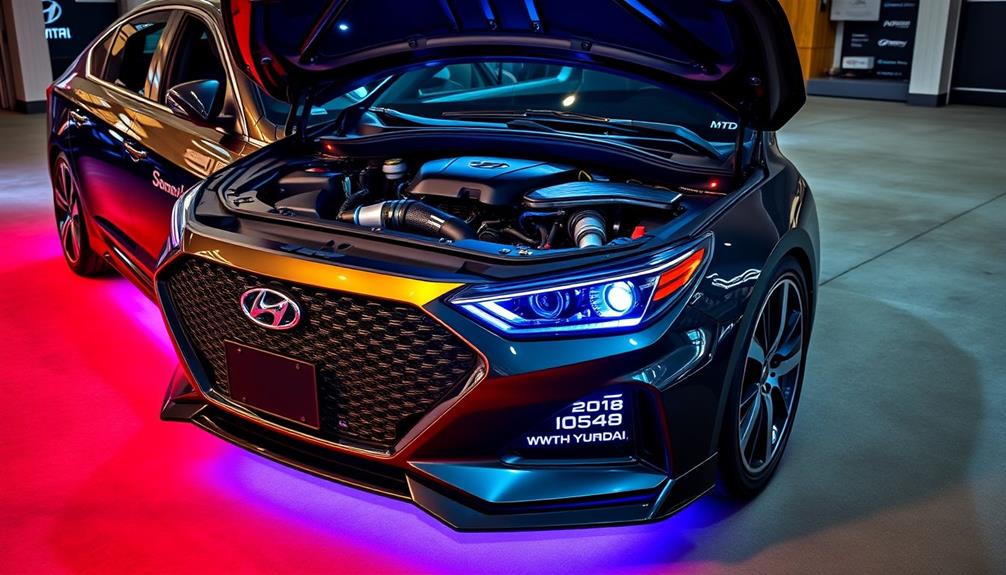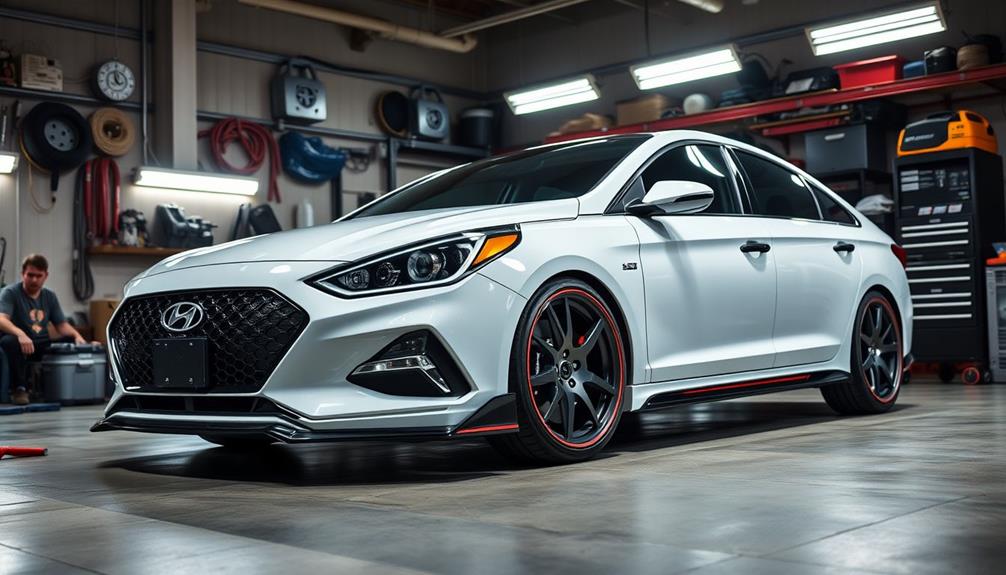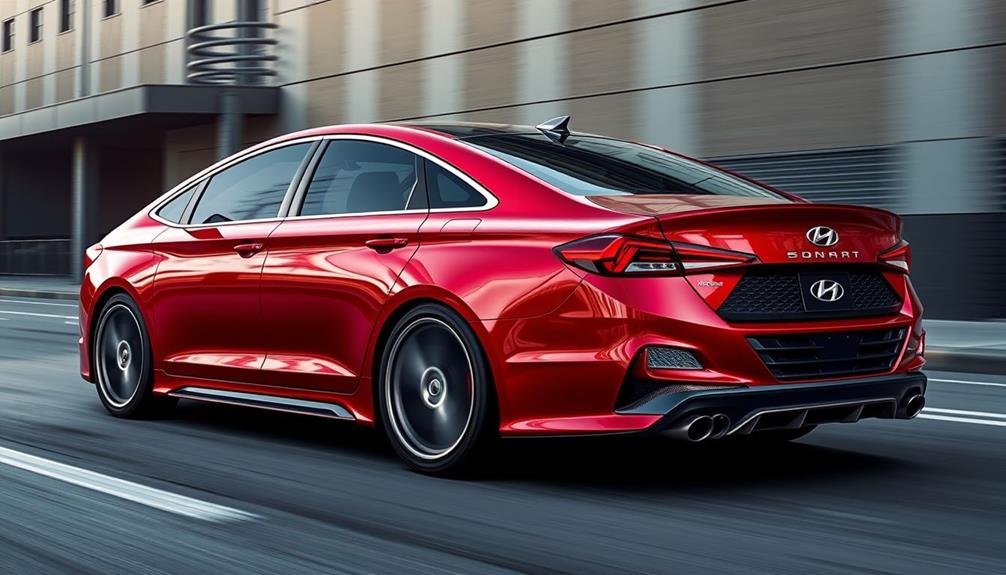You can easily transform your 2018 Hyundai Sonata into a performance machine by focusing on key tuning areas. Start with suspension upgrades, like coilovers or sway bars, to enhance handling. Upgrade your braking system with big brake kits for better stopping power. For power, consider tuning your turbocharged engine with performance tuners that can boost horsepower markedly. Keep in mind the importance of regular maintenance to support these enhancements and check warranty implications before making changes. There's more you can explore about maximizing your Sonata's performance potential.
Key Takeaways
- Upgrade to coilovers or air suspension for improved handling, ride quality, and adjustable ride height tailored to your driving needs.
- Install a big brake kit featuring lightweight calipers and larger rotors for enhanced stopping power and improved handling dynamics.
- Consider performance tuning options like Uncle Lap3 or JB4 to boost horsepower by 30-40 hp with proper ECU remapping.
- Follow a structured tuning stage approach, starting with ECU remapping and progressing to forced induction and internal engine modifications.
- Maintain detailed service records and perform regular maintenance to support modifications and protect your warranty coverage.
Overview of the Hyundai Sonata
The 2018 Hyundai Sonata stands out as a well-rounded mid-size sedan, blending style, performance, and advanced technology. You'll appreciate the sleek, modern design that catches eyes while you're on the road.
With its front-wheel-drive layout, the Sonata offers a smooth and engaging driving experience, making daily commutes enjoyable.
When it comes to performance upgrades, you have two impressive engine options. The base 2.4L I4 engine delivers 185 hp, providing solid power for everyday driving. If you're after more thrills, consider the turbocharged 2.0L I4 engine, which cranks out 245 hp, enhancing your performance considerably. This variety lets you choose what suits your driving style best.
In terms of practicality, the Sonata shines with its spacious interior and 16.3 cubic feet of trunk space. You won't feel cramped, and your gear will fit comfortably.
Plus, it boasts competitive fuel efficiency, achieving up to 25 mpg in the city and 35 mpg on the highway. Overall, the 2018 Hyundai Sonata is designed to elevate your driving experience while keeping fuel costs manageable.
Suspension Upgrades

Upgrading your Hyundai Sonata's suspension can drastically improve your driving experience.
With coilovers, you'll enjoy adjustable ride height and enhanced handling, while air suspension offers flexibility for both everyday use and show-stopping looks.
Adding sway bars tightens up cornering, ensuring your Sonata feels more responsive and stable on the road.
Coilover Suspension Benefits
Transform your Hyundai Sonata's ride quality and handling by considering coilover suspension upgrades. Coilovers are a game-changer, offering features that can greatly enhance your driving experience.
Here are three key benefits:
- Adjustable Ride Height: Tailor your Sonata's stance with an adjustable ride height, typically lowering it between 22mm to 42mm. This not only improves aesthetics but also enhances handling characteristics.
- Optimized Spring Rates: Coilovers come with spring rates designed for performance, effectively reducing body roll and increasing predictability during cornering. You'll notice a dramatic difference compared to factory setups, allowing for more spirited driving.
- Improved Responsiveness: Monotube coilover designs excel in responsiveness and heat dissipation, providing superior performance in dynamic driving conditions.
Plus, top mounts with pillowball bushings offer better feedback from the road, ensuring you stay connected to your Sonata's performance.
Upgrading to coilovers can turn your midsize sedan into a performance-oriented machine, delivering an exhilarating driving experience.
Don't settle for ordinary; elevate your Sonata with this essential upgrade!
Air Suspension Adjustability
If you're looking for a suspension upgrade that combines versatility with performance, air suspension might be the perfect choice for your 2018 Hyundai Sonata. This system offers impressive ride height adjustability, allowing you to customize your Sonata's stance anywhere from 0 to 120/200mm.
Whether you want a lower profile for daily driving or a raised height for rougher terrains, air suspension makes it easy to adapt to your needs.
One of the standout features of air suspension is its 36 levels of damping adjustment. This means you can fine-tune your ride quality for any road condition, ensuring a smooth experience whether you're cruising through the city or tackling a light track.
The high-quality air bags used in these systems are designed for durability, providing reliable performance that doesn't compromise comfort.
Installation is typically a straightforward, bolt-on process, requiring no modifications to your OEM components.
This accessibility makes it an attractive option for Sonata owners looking to enhance their vehicle's performance without the hassle.
With air suspension, you'll enjoy the perfect balance of adjustability and performance, making your Sonata a true standout on any road.
Sway Bar Enhancements
Sway bar enhancements often play a crucial role in elevating your 2018 Hyundai Sonata's handling dynamics. By reducing body roll during cornering, these upgrades help maintain tire contact with the road, boosting traction and confidence.
If you want to transform your Sonata into a true performance machine, consider the following benefits of sway bar enhancements:
- Stiffer Sway Bars: Upgrading to stiffer sway bars minimizes understeer, making your Sonata more responsive and agile when maneuvering turns.
- Thicker Bars: A thicker sway bar provides greater resistance against body roll, resulting in sharper steering responses that enhance your overall driving experience.
- Adjustable Endlinks: If you've lowered your vehicle, adjustable endlinks guarantee proper sway bar preload is maintained, optimizing performance after suspension modifications.
These sway bar upgrades aren't only effective but also a relatively inexpensive way to improve your Sonata's performance without needing extensive modifications.
With these enhancements, you'll enjoy a more engaging driving experience and increased driver confidence, turning your midsize sedan into a standout performer on the road.
Braking Performance Enhancements

When you're looking to upgrade your Hyundai Sonata's braking performance, investing in a big brake kit can make a world of difference.
These kits not only enhance stopping power but are also designed for easy installation, so you won't need a garage full of tools.
Don't forget, regular maintenance of your brake components is key to keeping everything running smoothly after your upgrade.
Big Brake Kit Benefits
Upgrading to a big brake kit can be one of the best decisions for enhancing your Hyundai Sonata's braking performance.
With the right components, you can markedly improve your vehicle's ability to handle aggressive driving conditions, ensuring safety and efficiency during spirited maneuvers.
Here are three key benefits of installing a big brake kit:
- Increased Stopping Power: The lightweight aircraft-grade aluminum calipers and larger rotors provide superior braking force, essential for high-performance builds.
- Reduced Brake Fade: Enhanced heat dissipation capabilities help maintain braking efficiency, preventing fade even during intense driving sessions.
- Improved Handling Dynamics: A big brake kit stabilizes your vehicle's handling characteristics, allowing for better control when cornering or during emergency stops.
Installation Process Overview
Installing a big brake kit on your 2018 Hyundai Sonata is a straightforward process that can considerably enhance your vehicle's braking performance.
You'll start with the Front Big Brake Kit, which features solid billet aluminum 8-piston calipers and 356 mm slotted rotors. This kit offers a simple bolt-on installation, requiring minimal tools and making it accessible for DIY enthusiasts.
Next, you'll move on to the Rear Big Brake Kit, designed for high-heat conditions. It includes lightweight aircraft-grade aluminum 6-piston calipers and 380 mm drilled rotors, guaranteeing your Sonata has the stopping power it needs.
Both kits are compatible with 2WD vehicles, emphasizing ease of installation.
During the installation process, verify you follow the manufacturer's instructions carefully to maintain vehicle safety.
Once installed, you'll notice a significant improvement in braking efficiency and overall performance.
Afterward, remember to regularly assess your brake components, especially if you plan on spirited driving or track use.
This proactive approach will help you maintain peak performance and safety, making your Sonata not just a midsize sedan but a refined performance machine.
Maintenance for Performance
Maintaining your Hyundai Sonata's braking performance is vital for both safety and driving enjoyment, especially after enhancing its power.
Once you've upgraded your braking system, it's important to keep it in top shape. Regular maintenance not only guarantees compatibility with your performance upgrades but also enhances overall safety during spirited driving.
Here are three key maintenance tips for your braking system:
- Inspect Brake Components: Regularly check your brake pads, rotors, and calipers for wear and tear. This is especially important after installing big brake kits, like the 15-18 rear kit or the 11-14 front kit.
- Monitor Brake Fluid: Confirm your brake fluid is at the correct level and free of contaminants. High-performance driving can generate heat, which may degrade fluid quality over time.
- Test Braking Performance: Periodically assess how your brakes respond under various conditions. If you feel any abnormal vibrations or noises, it may be time for professional evaluation.
Engine Modifications

When it comes to enhancing the performance of your 2018 Hyundai Sonata, engine modifications can make a notable difference in power and responsiveness. If you're equipped with the turbocharged 2.0T engine, you'll have more options for performance upgrades compared to the 2.4L engine. Performance tuners like Uncle Lap3 and JB4 can help boost your horsepower by 30-40 hp with proper tuning and modifications.
Here's a quick overview of tuning stages and their potential impact:
| Tuning Stage | Description |
|---|---|
| Basic Remapping | Adjusts engine settings for improved performance. |
| Suspension Upgrades | Enhances handling and stability during driving. |
| Forced Induction | Adds a turbocharger or supercharger for more power. |
| Internal Engine Mods | Upgrades components for higher durability and performance. |
| Advanced Tuning | Combines multiple mods for maximum output. |
Keep in mind that while these engine modifications can notably enhance the Sonata's performance, they may also have warranty implications. Regular maintenance is essential to guarantee your engine remains in top shape and to support the effectiveness of any performance upgrades you decide to pursue.
Warranty Considerations

Considering warranty implications is essential before diving into performance modifications on your 2018 Hyundai Sonata. Modifying key components, especially the engine or drivetrain, can void your existing warranty coverage.
It's important to understand how these changes could affect your vehicle's eligibility for warranty claims.
Here are three important factors to keep in mind:
- Documentation Matters: Regular maintenance records are critical. Make sure you keep track of all service records, as they can impact the validity of warranty claims if issues arise after modifications.
- Extended Warranty Options: An extended warranty can provide coverage for lower engine components, but only if regular maintenance, like oil changes, is documented within the last 12 months.
- Title Considerations: If your Sonata has a salvage or branded title, it won't be eligible for warranty coverage, which can limit your tuning options considerably.
Before you make any performance modifications, weigh these warranty implications carefully.
Protecting your investment and ensuring you have coverage when you need it's key to enjoying your enhanced Sonata without worry.
Community Engagement

Engaging with the Hyundai Sonata community can greatly enhance your tuning experience. With over 1.8 million posts in active forums, you'll find a treasure trove of information shared by Sonata owners like yourself. These platforms foster community engagement, where you can seek advice and learn about various performance upgrades and tuning techniques.
By participating in discussions, you'll gain insights into effective modifications and connect with fellow enthusiasts who are enthusiastic to share their knowledge. New members are welcome, and the supportive environment encourages questions, ensuring you feel comfortable diving into the world of tuning.
Additionally, you can explore social media platforms and video content that focus on Sonata enhancements. These resources offer visual demonstrations and real-life experiences, making the tuning process even more accessible.
As you engage with the community, remember to be mindful of warranty implications and maintenance strategies discussed among members. Informed decision-making is key to ensuring that your performance upgrades don't negatively impact your vehicle's longevity.
Maintenance Importance

Maintaining your 2018 Hyundai Sonata is crucial for keeping its engine running smoothly and maximizing performance. Regular maintenance not only enhances engine longevity but also guarantees peak performance. By staying on top of routine tasks, you can prevent costly repairs and maintain the reliability of your vehicle.
Here are three key maintenance practices to take into account:
- Oil Changes: Regular oil changes keep your engine lubricated and reduce wear over time, directly impacting engine longevity.
- Tire Pressure Checks: Proper tire pressure improves fuel efficiency and handling, contributing to overall vehicle reliability and safety.
- Fluid Inspections: Regularly checking and maintaining fluid levels—like coolant, brake, and transmission fluid—can prevent breakdowns and extend your Sonata's life.
Keeping detailed maintenance records is crucial, especially for warranty claims related to engine components.
Implementing preventive measures, such as timely replacement of worn parts, can further enhance your Sonata's performance and safety. Engaging with fellow Sonata owners in community forums can provide valuable insights and tips to help you maintain your vehicle effectively.
Tuning Stages and Options

Tuning your 2018 Hyundai Sonata opens up a world of performance enhancements tailored to your driving preferences. Hyundai h1 tuning allows for customization of the engine’s power output, suspension settings, and even the sound of the exhaust. Whether you prefer a more aggressive driving experience with increased horsepower, firmer suspension, and a louder exhaust note, or a more relaxed ride with improved fuel efficiency and a quieter exhaust, Hyundai h1 tuning can cater to your specific desires. With the ability to fine-tune your Sonata to match your driving style, you can truly make the car your own. Additionally, hyundai sonata 2008 tuning can offer many of the same dynamic upgrades, allowing owners of older models to enjoy modern performance improvements. From optimizing throttle response to refining gear shifts, both the 2018 and 2008 Sonata can be transformed into a vehicle that is uniquely suited to your preferences. Whether targeting efficiency or unleashing more power, tuning enhances the driving experience across various Sonata models.
You'll typically start with Stage 1 mods, which focus on ECU remapping, upgrading to alloy wheels, installing a sports exhaust, and enhancing suspension for improved handling. These performance modifications give you a noticeable boost without overwhelming your vehicle.
If you're looking for more power, consider Stage 2 enhancements. This stage often includes porting the head, upgrading the fuel pump, installing a power clutch, and utilizing high-flow injectors, all designed to elevate your Sonata's performance further.
For those ready to go all out, Stage 3 is where the magic happens. This stage involves thorough upgrades like forced induction systems, internal engine modifications, and specialized competition cams to maximize power output.
However, keep in mind that regular maintenance becomes vital as you increase power levels considerably to avoid engine failure.
Before diving into any tuning stages, it's important to understand the warranty implications. Many modifications may void your existing warranty, so make sure you're aware of what you're getting into.
Frequently Asked Questions
Can You Modify a Sonata?
Yes, you can modify a Sonata. You'll find plenty of options like performance chips, suspension upgrades, and brake kits. Just be aware that some modifications might void your warranty, so choose wisely.
Can You Turbo a Hyundai Sonata?
Sure, you can turbo a Hyundai Sonata! With proper tuning, you could boost horsepower by 30-40 hp. Just remember, upgrading components like the intercooler and exhaust is essential for handling that extra power effectively.
Is 2018 a Good Year for Hyundai Sonata?
Yes, 2018's a great year for the Hyundai Sonata. It combines style, advanced safety features, and a range of solid engine options, making it perfect for daily driving and potential performance enhancements. You'll love it!
Is There a Recall on the 2018 Hyundai Sonata?
No, there aren't any widespread recalls for the 2018 Hyundai Sonata as of now. However, it's wise to check the NHTSA website periodically to stay updated on any potential safety alerts or recalls.
Conclusion
As you immerse yourself in tuning your 2018 Hyundai Sonata, imagine it transforming from a reliable sedan into a thrilling performance machine, much like a caterpillar becoming a butterfly. Upgrading the suspension and brakes, along with engine tweaks, can elevate your driving experience. Just remember to balance modifications with warranty considerations and maintenance. Join the community of enthusiasts who share your passion, and enjoy the journey of making your Sonata uniquely yours, one upgrade at a time.










